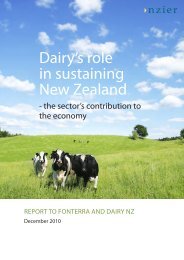NZIER report on compensation for transmission infrastructure
NZIER report on compensation for transmission infrastructure
NZIER report on compensation for transmission infrastructure
You also want an ePaper? Increase the reach of your titles
YUMPU automatically turns print PDFs into web optimized ePapers that Google loves.
thought approximately 90 percent of landowners affected by the new line would take<br />
them to the Alberta SRB (Beesley 2008).<br />
This highlights two things. First, an increase in compensati<strong>on</strong> may decrease net<br />
easement costs to the utility by lowering transacti<strong>on</strong> costs and decreasing the time<br />
required to reach settlement. Sec<strong>on</strong>d, the presence of a powerful landowners‟<br />
advocate can significantly improve the outcome <strong>for</strong> landowners. This in turn shows<br />
that compensati<strong>on</strong> amount is a functi<strong>on</strong> of relative negotiating strengths.<br />
3.7 Negotiati<strong>on</strong>s<br />
How a surplus is split between landowners and utilities (and payment method)<br />
appear to be more a matter of negotiating strength than fairness. Generally, countries<br />
with more powerful landowner representative groups have significantly better<br />
easement outcomes <strong>for</strong> landowners. Alberta and Québec both have str<strong>on</strong>g bodies<br />
representing landowners‟ rights in easement negotiati<strong>on</strong>s and generous<br />
compensati<strong>on</strong> packages relative to many other countries (see Hydro-Québec 2000<br />
and the Alberta Surface Rights and Land Compensati<strong>on</strong> Board). 19<br />
Elsewhere landowners negotiate largely as individuals with utilities who, in these<br />
circumstances, have significant bargaining advantages. Utilities are larger, better<br />
able to af<strong>for</strong>d legal costs, more experienced at negotiating easements and have the<br />
threat of compulsory acquisiti<strong>on</strong>. Even though compulsory purchase powers are<br />
seldom exercised the presence of such powers is thought to be enough to sway<br />
negotiati<strong>on</strong>s (Hutchis<strong>on</strong> et al 1998).<br />
Kalbro and Lind (1999) use experiments to examine how surpluses are split between<br />
dominant and servient estates. Their findings suggest that compulsory acquisiti<strong>on</strong><br />
powers result in <strong>infrastructure</strong> owners getting, <strong>on</strong> average, two thirds, of the surplus.<br />
Dominant estates tend to start the bargaining process by offering compensati<strong>on</strong> <strong>for</strong><br />
damages <strong>on</strong>ly, whereas the servient estate starts with an equal split plus some<br />
bargaining margin, generally around 0.6 to 0.8 (Kalbro and Lind 1999). This supports<br />
our earlier comment that how a surplus is split is determined by relative negotiating<br />
strengths.<br />
19 Alberta Surface Rights and Land Compensati<strong>on</strong> Board at http://www.srblcb.gov.ab.ca/<br />
<str<strong>on</strong>g>NZIER</str<strong>on</strong>g> – Compensati<strong>on</strong> <strong>for</strong> transmissi<strong>on</strong> <strong>infrastructure</strong> 26
















